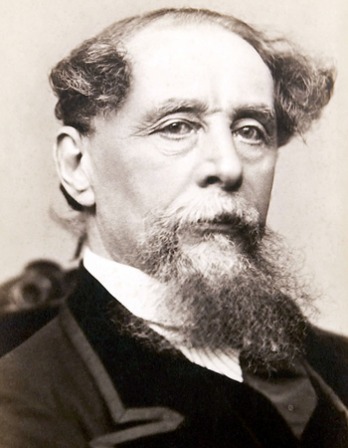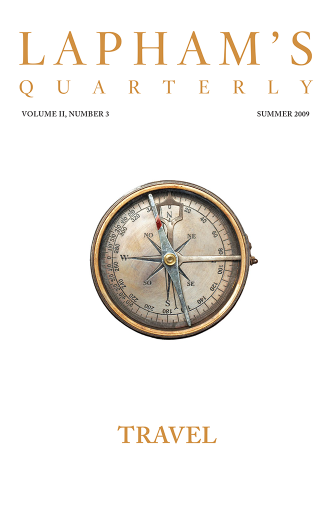It is difficult to get a man to understand something when his salary depends upon his not understanding it.
—Upton Sinclair, 1935Lost Tools
A tour of the antique tool trade confirms that they just don’t make things like they used to.
By Donovan Hohn
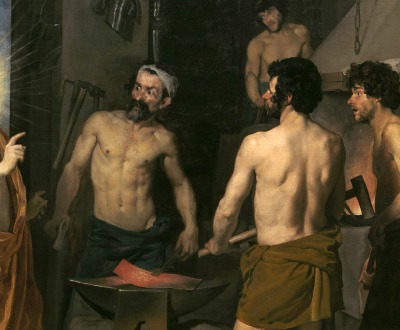
Apollo in the Forge of Vulcan, by Diego Velázquez, 1630. Museo del Prado, Madrid.
If you had asked me several years ago what I thought of tool collecting, I would have told you that it sounded like the sort of sentimental pastime pursued by men with soft minds, thick wallets, and lonely wives. In Manhattan, where I lived, one encountered woodworking tools and farming implements on the walls of pastorally themed restaurants serving expensive comfort food or among handmade quilts and kerosene lanterns in the windows of West Village boutiques. I considered such Americana so much nostalgic gimcrack. The inflated prices that old tools commanded I attributed to an ambient dissatisfaction with modernity. The more expendable we felt in our jobs, the more complicated and computerized our lives became, the more hardware made of metal and wood came to symbolize all that we had lost—we Americans, but especially we American men.
Until recently in America, manliness was proportionate to handiness. The ancient Greeks had Achilles and his shield. The British had Arthur and Excalibur. We had John Henry and his hammer, Paul Bunyan and his axe, Queequeg and his harpoon. Our national poets sang hymns to the broadaxe and the village blacksmith. Our prophets didn’t merely wander in the wilderness, they built cabins there. The adzes and bow saws with which anxiety-beset urban professionals now equip their apartments originally belonged to self-reliant, self-employed, self-made yeomen—or so the traffickers in nostalgia wished us to believe.
It was a lie, I knew, this Luddite fantasy of an artisanal golden age. That legendary Yankee ingenuity was born not only out of an ardor for craftsmanship and independence but also out of a shortage of skilled labor and an abundance of cheap, pilfered land. European settlers had picked up many of their tricks (hollowing a canoe with fire, fertilizing corn with fish) from natives whom they repaid with smallpox and firewater. And besides, mowing a hay field by hand was backbreaking work, nothing romantic about it. Homespun textiles required endless, mind-numbing cottage industry. No wonder so many of our agrarian forebears fled to cities at the first chance they got, or else bet the farm on motorized combines and harvesters.
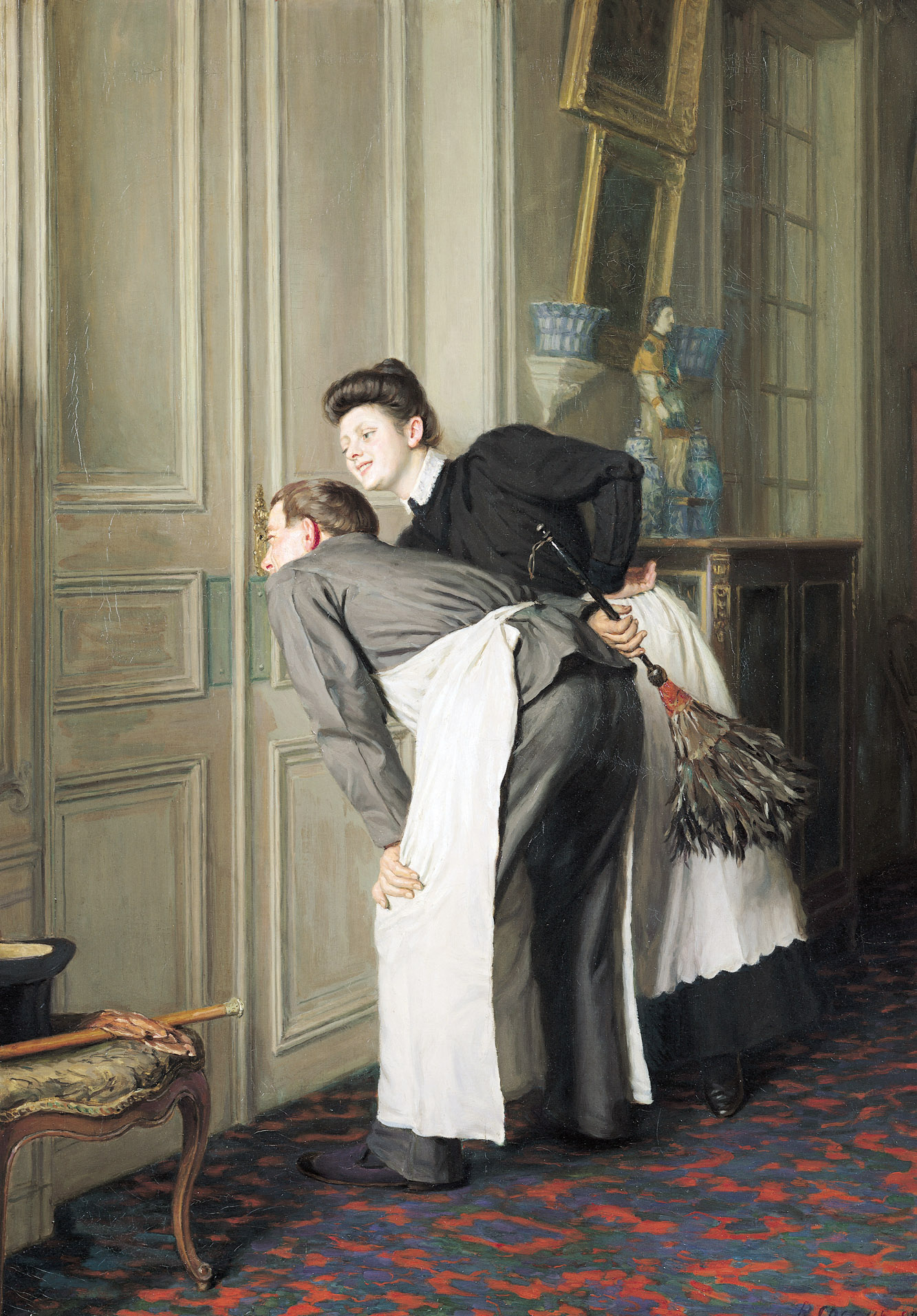
Madame Recoit, by Remy Cogghe, 1908. Musée d'Art et d'Industrie de Roubaix, France.
I also had personal reasons to be suspicious of tool collecting. Although I come from a family of insufferably handy men—men able to wire a house, rebuild a transmission, frame a wall without calling an expert or consulting a book—I am profoundly unhandy. By the traditional measures of American manhood, I am, essentially, a Frenchwoman.
One might, therefore, find it strange or worrisome that one summer not long ago I devoted every waking hour I could spare to the study of old tools, reading books with titles like Wrenches: Antique and Unusual and The Hammer: The King of Tools. I stayed up all night browsing the searchable archives of the U.S. Patent and Trademark Office, encountering there such exotic utensils as the Clamp Fur-Knife, which, when “Edward Flint, of the city, county, and State of New York,” registered his invention in 1837, was “a new and useful Instrument for Extracting Hairs from Fur-Skins.” Mostly, I rode a Midwestern circuit of flea markets and farm auctions in the passenger seat of an emerald-green Toyota pickup truck piloted by a fifty-five-year-old botanist with a ponytail, spectacles like windowpanes, and a beard bordering on the Whitmanesque.
Tom Friedlander is a tall, faintly melancholy man, prone to long silences and outbursts of goofiness, whom I have always known as Uncle Tom. In 1976, Tom joined his wife, Martha, my father’s sister, in the biology department of a private high school in Ann Arbor, Michigan. By the late 1980s they had saved enough to purchase a ranch house in the rural exurbs, along with the thirty-seven acres of marshy, unprofitable farmland adjoining it, which they subsequently let run wild.
For years I’d been meaning to visit them there. I finally did in 2002. Upon entering their ranch house, I stopped short. Strung on wires and depending from nails hung thousands, or maybe even tens of thousands, of keys. Some strands drooped in elliptical wreaths. Others contorted themselves into asymmetrical Mobius strips and figure eights. The longest strands described arcs across the floral wallpaper, like bunting. The shortest bristled in shiny bouquets.
Tom led me down half a flight of stairs to the television den, where a mob of brass hose nozzles had stormed the mantelpiece and platoons of stove-plate handles flanked the wood-burning stove. Other objects were mounted according to kind on graying scraps of plywood, which leaned about the room—against bookshelves, in corners—like canvasses about a painter’s studio. There was a board containing sillcock grips, those spigot handles shaped like cross-sections of bell pepper, some of them red, some blue, some green, some rusty and bare. Other boards contained screwdrivers, locks, shower heads.
I asked him how large his tool collection was, and he led me to his study, where homemade shelves teetered under the weight of old hardware catalogues and reference books, such as P.T. Rathbone’s History of Old Time Farm Implement Companies and the Wrenches They Issued and Eric Sloane’s classic A Museum of Early American Tools. From a nail in the doorway hung a clipboard, to which was clipped a stack of sheets. This was Tom’s penciled inventory. Since 1988 he’d accumulated approximately 25,000 formerly useful things, not counting the keys. The exhibit in the television den represented only a small sample of the permanent collection.
The prefabricated steel outbuilding in which he warehoused the bulk of his inventory was the size of a two-car garage. We entered through a side door, stepping awkwardly over three metal spheres as large as medicine balls while fluorescent tubes flickered on overhead. My first impression was an abstraction: I did not see the hundreds of handsaws hanging from pegs like keys in a locksmith’s shop, or the iron shoe-lasts arranged in pigeonholes according to size, or the towering steel file cabinets with handwritten tags taped above their handles, or the railroad jacks congregating on a shelf or the flock of meat scales and wooden pulleys suspended from the ceiling by hooks; I only saw the idea of multitude. “Be fruitful and multiply,” the Lord commanded, and we had, we Americans; here all around us was our labor’s rusty fruit.
“There are over five hundred drawers full of stuff in here. It’s all organized,” Tom said. As we made our way slowly down the crowded aisles, what struck me most was how zoological Tom’s tools were, especially the more exotic ones. Divorced from utility and subjected to morphological classification, they looked like the fossils of Cenozoic mollusks or the wrist bones of tyrannosaurs. Certain pliers bore striking resemblances to the beaks of birds, certain wrenches to the jaws of lizards. The points of chisels and awls looked like talons and claws. Even the names of tools suggested members of the animal kingdom; there was a goosewing axe, an alligator wrench, a mortising twivil called a bec d’âne, French for “nose of a donkey.” It is, in fact, impossible to talk about tools without resorting to biological metaphors. We refer to the “head” and “claw” of a hammer, the “frog” and “throat” of a plane, the “jaws” of a vise, the “eye” of an adze.
The following June my tool-hunting safari began. At the first auction Tom took me to, most of the auctiongoers were elderly farmers in ball caps emblazoned with logos and slogans: “Rifkin Scrap Iron & Metal Co.,” “I’d Rather Be Hunting,” “Westphalia Auto Salvage,” “Purina,” “God Bless America,” “Mr. Asphalt.” With his ponytail and great Victorian beard, Tom seemed as out of place among them as Charles Darwin among the Patagonians. Save for his blue cap, across which a galleon embroidered from gold thread sailed above the legend “HMS Victory,” and his brown hiking sneakers, he was dressed entirely in green—green work pants, green work shirt—and vaguely resembled a plant.
Inches above the auctioneer, under the humid eaves of an almost empty shed, wasps bounced as if on strings, tending their paper nests. Atop one of three hay wagons, a skinny teenage boy with a crew cut stooped down to the rusty junk piled at his feet and hoisted a bow saw into the air—an exquisite specimen, just like the ones I’d seen in books. “Lift her up nice and high, Ben,” the auctioneer, a paunchy man in suspenders, barked into his miked headset. Bow saws are shaped like the harps that angels in comic strips play. They’re both ingenious and primitive, held together by the tension in a twisted loop of rope. “Howaboutabid, twenty,” the auctioneer chanted. “I’ve got twenty. Howaboutabid, twenty-five-five-five? Twenty-five. Twenty-seven-and-a-half? Now thirty. Thirty, thirty, thirty?”
The bow saw finally sold for $87.50, and Ben the teenage sideman next lifted an ink-jet printer into the air. “Something for your computer,” the auctioneer said, doubtfully. He commenced the bidding at fifty, let it fall to forty, twenty-five, ten, seven, at which point he gave up and banished the printer to “the dog pond,” a corner of the shed reserved for the unwanted.

The Floor Scrapers, by Gustave Caillebotte, 1876. Private Collection.
“Nowadays things are almost obsolete before they leave the drawing board,” Eric Sloane, the seminal romancer of antique tools, observed almost fifty years ago. “How lucky we are that so many of the old tools and the things that were made with them were dated and touched with the craftsman’s art.” Sloane believed that the value of a thing should be a measure of its quality, much as reputation was once the measure of one’s soul. My generation, more narcissistic but also more jaded than his, treasures most the consumerist dross we remember from childhood, irrespective of its inherent worth. In our collecting we are autobiographers, not connoisseurs. I find myself wondering how long it will take before that ink-jet printer escapes the dog pond and ascends to the ranks of the collectible.
When he published A Museum of Early American Tools in 1964, Sloane almost singlehandedly turned old tools into Americana. The ancient implements it depicts, Sloane’s dedication informs us, are not only tools but “symbols of a sincerity, an integrity, and an excellency that the unionized craftsman of today might do well to emulate.” His story of decline has no room for tenant farmers, migrant workers, sweatshops, displaced natives, slaves; rather, it celebrates the versatile but mediocre American craftsmen, those jacks of all trades. The carpenter on the Pequod, whom
Herman Melville describes as “omnitooled,” is “to a certain offhanded, practical extent, alike experienced in numerous trades and callings collateral to his own.” In addition to maintaining the seaworthiness of the ship, he performs dental surgery, repairs Ahab’s prosthetic leg, and decorates the second mate’s oars with constellations of vermilion stars. The harmony that the craftsman once felt with his material and tools is, as Sloane describes it, not unlike that which once existed between Adam and the beasts. “An extraordinary awareness of life and time permeated our early days,” he writes. Again and again in the commentary that accompanies his old-timey pen-and-ink drawings of apple barrows and hay forks, he praises the craftsmen of yore at the expense of “modern workers,” whose “constant aim is more to make the most money from their profession instead of producing the most honest and beautiful and lasting things.”
To this day on the antique tool market, Eric Sloane’s romantic biases persist. Wood sells better than metal, metal better than plastic. Carpentry tools sell better than those of other crafts and trades. The plane, certain rare specimens of which have been known to fetch $20,000 or more, is probably the most collectible tool there is. The wrench, Tom Friedlander’s specialty, is far less so. Used by carpenters of the Roman Empire, the plane could have been utilized by Jesus Christ himself, before he gave up woodworking for the Word. A hundred years ago, a carpenter’s tool chest typically would have contained dozens of varieties of planes, and a typical hardware catalogue would list hundreds of varieties (astragals, fillisters, snipe bills, ogees, Grecian ovolos), each one adapted to a highly specialized purpose. Shipwrights smoothed the decks of ships with planes resembling horseshoe crabs, and violin makers carved fiddleheads with planes, made from lignum vitae, that were smaller than a thumb. Then, at the end of the nineteenth century, what the jigsaw did to the bow-saw, planing machines did to planes. By the mid-1900s in New England, obsolete planes were being sold as firewood for as little as five dollars a barrel.
The twilight of the plane was the heyday of the wrench.
Leonardo da Vinci is said to have doodled designs for an adjustable wrench in his notebooks, but it was with the invention of bolt-threading machines in the early 1800s that the wrench became as useful and as common as the hammer. In 1869 a writer for Scientific American, marveling at how “rude and uncouth” old tools were compared with the machine-lathed wonders of his day, described antebellum wrenches as being mostly of “the pot-hook variety.” The history of the wrench is the history of industrialism writ small. No matter how many farmers use them, no matter how mechanized agriculture becomes, on the antique-tool market, wrenches symbolize pastoralism’s antithesis. Of metal for metal, they are the emblem of mechanics and machinists, the standard raised in the fists of factory workers in revolutionary murals. They are the tool of the unionized masses, not the self-reliant yeoman or artisan. Wrenches assemble and adjust; they do not make. There are no wrenches in Eric Sloane’s Museum.
Time, it seems, is an ironist. That summer, factory workers were being laid off in droves, and the riveters and machine operators Sloane derided seemed like skilled artisans compared with the technicians and sales associates replacing them. The era of the wrench, like the era of the plane before it, is ending. Predictably, the ranks of wrench collectors recently have begun to swell. Although still worth far less than a desirable plane, a rare and pristine John Deere tractor wrench can now fetch hundreds of dollars at auction. Partly this reflects the enthusiasm in rural America for the antique tractors with which such wrenches were originally sold. But the popularity of other wrench varieties—pipe wrenches, automobile wrenches, buggy wrenches, battery-cable-pulling wrenches—is also growing. The decline of American manufacturing has given rise to pastoralism’s postindustrial analogue: a romance of rust.
It is a commonplace that in the era of consumerism we are what we possess. Usually this is noted as a cause for worry, another symptom of cultural decline, and perhaps it is. Still, when you visit estate auctions, it is hard not to be moved to pity and awe. Gathered on lawns and hay wagons, items explain one another like words in a language. However miscellaneous they seem, these belongings share a kind of logic—the ordering principle of a human personality. One can trace among them the lineaments of an inner life. Political affiliations, religious beliefs, memories, vanities, even dreams, are spread out for strangers to browse through. Here is a man’s hairpiece, his wooden crutches, his map of the world festooned with faded stamps. At another auction on another farm in another material universe, the items on offer include the October 1959 issue of Marriage: The Magazine of Catholic Family Living, a USDA bulletin called Making Cellars Dry, a miniature souvenir tool kit commemorating the Catholic shrine at Indian River, Michigan, and three framed jigsaw puzzles of pastoral scenes—sheep, glades, brooks.
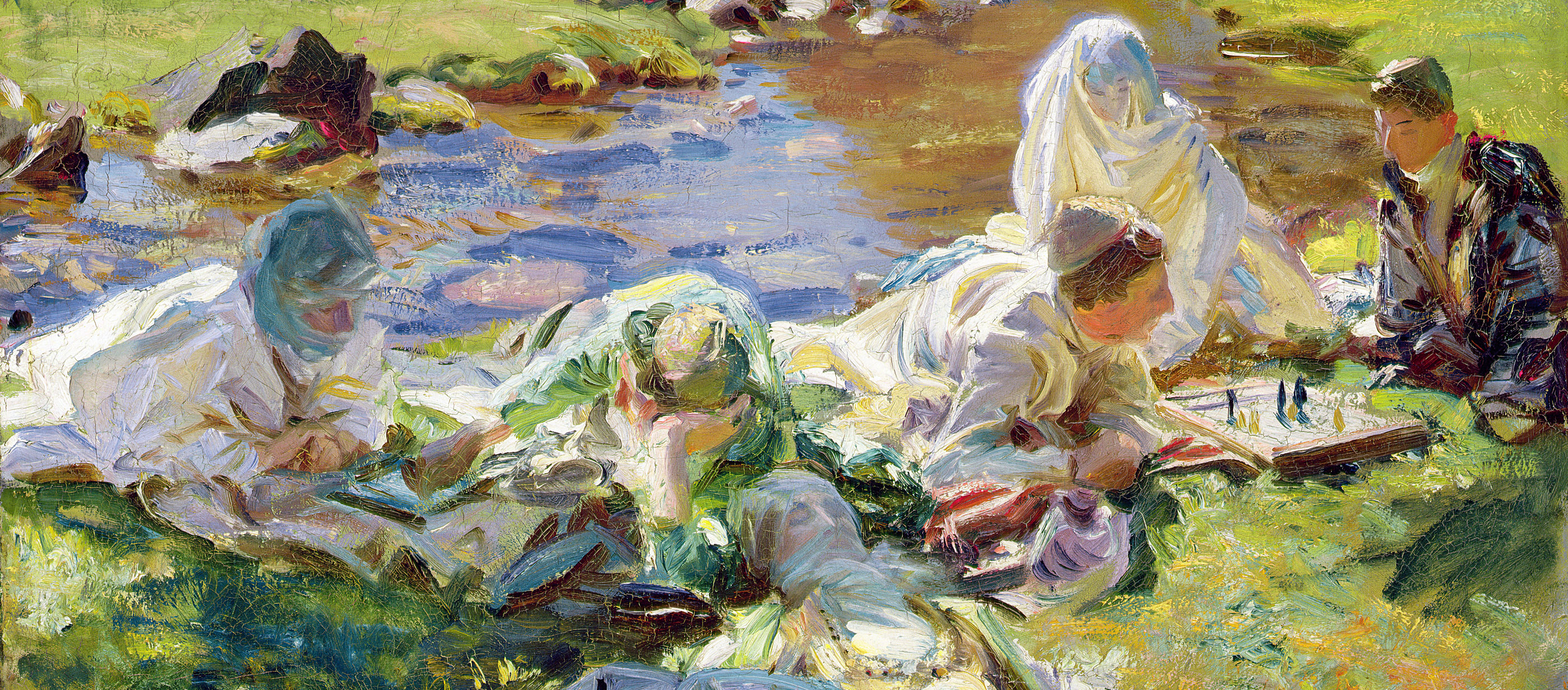
Dolce Far Niente, by John Singer Sargent, c. 1907. Brooklyn Museum, New York.
Today we refer to anything useful, from computer programs to ideas, as tools. This was not always the case. In antebellum America the word “tool” denoted an implement that could make one thing at a time. Reconstruction-era industrialization broadened the meaning of the word to include any implement involved in the manufacture of a product, necessitating the coinage of the term “hand tool” to distinguish traditional implements from what came to be known as machines. The difference between these two mechanical species, it seems to me, may be more a matter of culture than of engineering. Machines are both the rival and the antithesis of humanity. In their complexity they resemble us. In their simplicity (all those moving parts, and yet no Oedipus complex, no withdrawal symptoms, no fear of death, no ecstasy), they are monstrous—or as William Blake put it, “satanic.” Machines are largely autonomous and threaten us with obsolescence, whereas a tool is nothing without us.
“Like the nails on a beast’s paws,” Eric Sloane writes, “the old tools were so much an extension of a man’s hand or an added appendage to his arm, that the resulting workmanship seemed to flow directly from the body of the maker and to carry something of himself into the work.” Although Sloane was an antiunionist libertarian, on the meaning of tools he and the author of the Communist Manifesto agree. “In his work,” writes Karl Marx, “[the laborer] does not affirm himself but denies himself.” For the most serious tool aficionados, or “galoots,” as they sometimes call themselves, the hegemony of mind and machine over hand and matter entails an estrangement more profound even than the one Marx imagined, an estrangement not only from self but from time. For them, old tools are relics of a mythic past, but they are also antidotes to automation, standardization, acceleration, infantilization, and to the docile brand of utopianism that holds all change to be progress.
Once upon a time, we referred to all forms of manufacturing (a Latinate word for “making by hand”) as “the arts,” and once upon a time all artists, manual as well as fine, could find meaning in their work. “There is something missing in our definition, vision, of a human being: the need to make,” the poet Frank Bidart observed in a sequence of poems devoted to the topic of making. “The culture in which we live honors specific kinds of making (shaping or misshaping a business, a family) but does not understand how central making itself is as manifestation and mirror of the self, fundamental as eating or sleeping.” The worship of old tools arises, I have begun to suspect, from the epidemic frustration of this need.
That’s one explanation. There is also, I think, something deeply and peculiarly American about the worship of old tools. History tends to memorialize great change, which, technologically speaking, means great inventions. Tools are inherently conservative and humble artifacts. Their history is largely tangential, written in the margins—of warfare, architecture, economics, religion. Inventions are the generals, the geniuses, the monarchs of history; tools are the commoners, the craftsmen, the serfs. Here, then, is another reason old tools have become Americana. At once democratic and utilitarian, individualistic and traditional, they resemble us. They are technological leaves of grass. Wrenches and planes are to American civilization what amphoras and urns were to the ancient Greeks, common artifacts the ubiquity and durability of which attest to their cultural importance and ensure that they will last. Like the Grecian urn in John Keats’ ode, they are the foster children of silence and slow time. Long after the mills crumble into the millponds and the cornfields sprout subdivisions, long after the sweatshops are condemned and the machines sold off as scrap, tools remain.
Upon returning from our last tool-hunting expedition of the season that year, I helped Tom sort through a truckload of rusty treasure, spread out on the lowered tailgate of his pickup. The hunting today had been unusually good. “Whee!” Tom sang, “Christmas in August!” It was a perfect late-summer afternoon. The cattails in the wetlands had grown as tall as trees. The light was golden. The goldenrod was a yellow sea. The grass beside Tom’s arklike toolshed was long and spangled with dandelions. Among them, I noticed first one little Day-Glo orange flag, then another, then another. There were four in all. They indicated the location of a museum Tom hoped to build. He imagined a brightly lit exhibition space in which he would mount his 25,000 tools on plywood and hang them from walls. I wondered who it was he thought his museum would attract, or if it even mattered. If he were his museum’s only patron, I felt certain, he would keep rescuing tools, classifying, and displaying them. Identification is for him akin to benediction, and salvage akin to salvation.
After we’d archived his new acquisitions, I lingered alone in the outbuilding. Outside, the world was hot and bright, but in here it was cool and dark. It smelled of grease, dirt, concrete, rust. There were no windows. One might as well have been underground, in a cave—or in a dream. The shapes of the tools were fabulous, as was their multitude.
“Democratic peoples scarcely worry about what has been,” Alexis de Tocqueville wrote, “but they willingly dream of what will be, and in this direction their imagination has no limits; here it stretches and enlarges itself beyond measure.” To the degree that this was ever true, I doubt it is any longer. At some point in the 180 years that have elapsed since the French aristocrat came to observe the American experiment in democracy—perhaps when the frontier closed, or perhaps when men became, in Henry David Thoreau’s words, “the tools of their tools”—the future loosened its purchase on our dreams. This is not to say that Americans have collectively lost faith in progress, only that our imaginations face in two directions. Newer is still better, but now we are nostalgic for almost everything.


